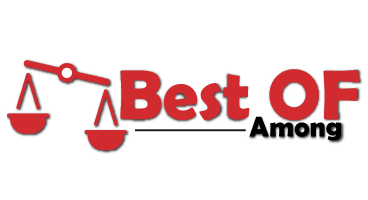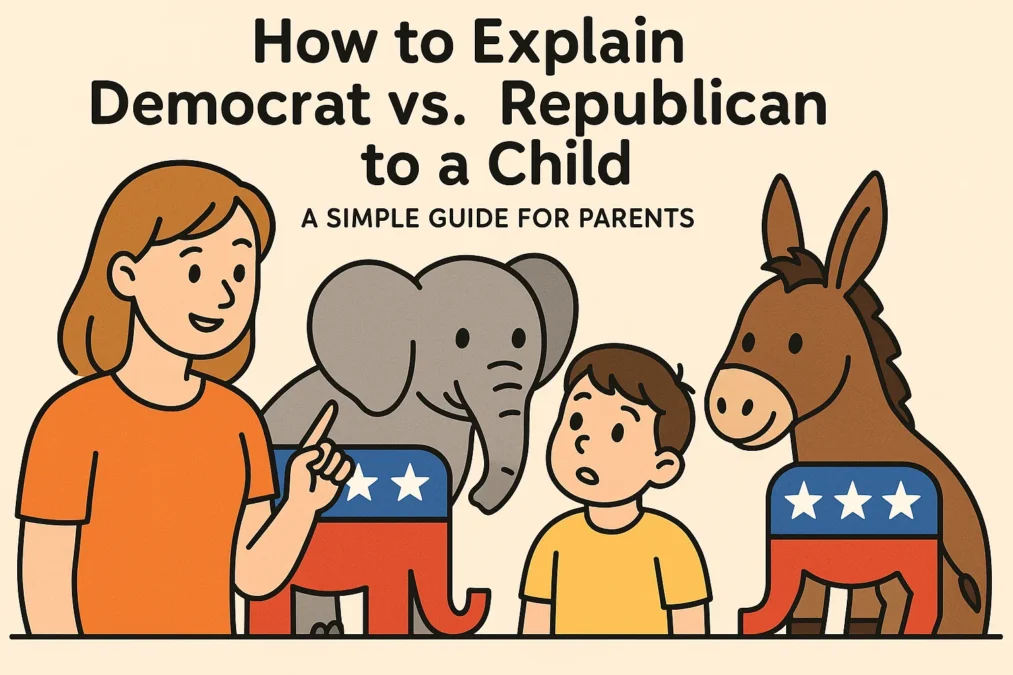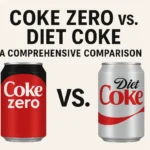Democrat vs Republican: Politics can feel like a maze of big words, heated debates, and confusing ideas. But when your child asks, “What’s the difference between Democrats and Republicans?” it’s a golden opportunity to teach them about how the world works. Explaining politics to kids doesn’t have to be overwhelming. With the right approach, you can break it down in a way that’s fun, relatable, and easy to understand. Let’s dive in!
Why It’s Important to Teach Kids About Politics
Teaching kids about politics isn’t just about explaining who’s who in government. It’s about helping them understand how decisions are made, why people have different opinions, and how they can be part of shaping the world around them.
Building Critical Thinking Skills
When kids learn about political differences, they start to think critically. They learn to ask questions like, “Why do people believe this?” or “How does this affect others?” This kind of thinking helps them make sense of the world and form their own opinions.
Encouraging Respectful Dialogue
Politics can get heated, but teaching kids about it early helps them understand that it’s okay to disagree. They learn to listen to others, even if they don’t agree, and to express their own ideas respectfully.
Preparing for Civic Engagement
Kids who understand politics are more likely to grow into adults who vote, volunteer, and care about their communities. By teaching them now, you’re helping them become active, informed citizens in the future.
Start with the Basics: What Are Democrats and Republicans?
Before diving into policies and philosophies, it’s important to explain the basics. Think of it like introducing two teams in a game—each has its own colors, mascots, and goals.
Democrats: The Blue Team
Democrats are often associated with the color blue and a donkey as their mascot. They’re sometimes called “liberals” or “the left.” Democrats generally believe that the government should play a big role in helping people, especially when it comes to things like healthcare, education, and protecting the environment.
Republicans: The Red Team
Republicans are linked to the color red and an elephant as their mascot. They’re often called “conservatives” or “the right.” Republicans usually believe in smaller government, individual freedom, and letting people and businesses make their own decisions.
Use Simple Metaphors Democrat vs Republican
Kids learn best through stories and comparisons. Here are some easy metaphors to help them understand the core differences between Democrats and Republicans.
The Playground Metaphor
Imagine a playground where kids are playing together. Democrats might say, “Let’s all share the toys so everyone has fun.” They believe in teamwork and making sure no one is left out. Republicans, on the other hand, might say, “Let’s each bring our own toys and take care of them.” They believe in personal responsibility and letting kids decide how to play.
The Dinner Table Metaphor
Think of a family dinner. Democrats might suggest, “Let’s all cook together and share the meal.” They focus on working as a group and making sure everyone is fed. Republicans might say, “Let’s each make our own dish and bring it to the table.” They emphasize individual effort and choice.
Relate Politics to Their World
Kids are more likely to understand politics if you connect it to their everyday lives. Here’s how you can do that.
School Rules
Democrats might support rules that ensure every student gets the same resources, like textbooks and school supplies. Republicans might argue that schools should have more freedom to decide how to use their resources, with less interference from the government.
Allowance and Spending
If you give your child an allowance, you can explain taxes and spending. Democrats might say, “Let’s pool some of your allowance to buy something everyone can enjoy, like a family game.” Republicans might say, “Keep your allowance and decide how to spend it yourself.”
Explain How Democrats and Republicans See Problems
Democrats and Republicans often agree on the problems but disagree on how to solve them. Here’s how you can explain their approaches.
Democrats: Teamwork and Rules
Democrats tend to believe that problems are best solved by working together and creating rules to help everyone. For example, if there’s a problem with pollution, Democrats might support laws to limit emissions and protect the environment.
Republicans: Individual Responsibility
Republicans often think that people and businesses should solve problems on their own, with less government involvement. In the pollution example, Republicans might encourage companies to find their own ways to reduce emissions without strict regulations.
Money Talks: How the Parties Want Us to Spend It
Money is a big part of politics, and it’s something kids can understand. Here’s how Democrats and Republicans approach spending.
Democrats: Sharing Resources
Democrats believe in using taxes to fund programs that help everyone, like schools, healthcare, and public parks. They think it’s fair for people who earn more to contribute more.
Republicans: Keeping More of Your Money
Republicans prefer lower taxes and less government spending. They believe people should keep more of their money and decide how to spend it themselves.
Women’s Rights: Why Everyone Deserves a Fair Chance
Kids understand fairness, so this is a great way to explain how Democrats and Republicans view equality.
Democrats: Equal Opportunities for All
Democrats often support laws that ensure women have the same opportunities as men, whether it’s in the workplace, at school, or in politics.
Republicans: Freedom to Choose
Republicans also believe in equality but often prefer to let individuals and businesses handle these issues without too much government involvement.
Education: Why Going to School Helps Everyone
Education is something kids can relate to, making it a perfect topic for explaining political differences.
Democrats: More Funding for Schools
Democrats usually support more government funding for education to ensure all kids have access to good schools and resources.
Republicans: Local Control
Republicans often believe that local communities and parents should have more say in how schools are run, with less interference from the federal government.
Healthcare: Keeping Everyone Healthy
Healthcare is another topic that affects everyone, including kids.
Democrats: Affordable Care for All
Democrats often support government programs to make healthcare more affordable and accessible for everyone.
Republicans: Personal Choice
Republicans usually prefer private healthcare options and believe people should have the freedom to choose their own plans.
Immigration: Why Some People Move to New Places
Immigration can be a tricky topic, but it’s important to explain it in a way kids can understand.
Democrats: Welcoming Newcomers
Democrats often support policies that make it easier for people to immigrate, especially if they’re fleeing difficult situations in their home countries.
Republicans: Controlled Immigration
Republicans usually believe in stricter rules for immigration to ensure safety and order.
Taxes: Who Pays What?
Taxes are a big part of politics, and you can explain them using simple examples.
Democrats: Sharing the Load
Democrats believe that people who earn more should pay more in taxes to help fund public services.
Republicans: Keeping It Fair
Republicans think everyone should pay lower taxes and have more control over how they spend their money.
Climate Change: Protecting the Planet
Kids care about the environment, so this is a great topic to discuss.
Democrats: Big Changes
Democrats often support government action to address climate change, like reducing emissions and investing in renewable energy.
Republicans: Balancing Act
Republicans believe in finding a balance between protecting the environment and supporting businesses and jobs.
Conclusion: Making Politics Fun and Easy
Explaining politics to kids doesn’t have to be hard. By using simple metaphors, relatable examples, and a bit of creativity, you can help your child understand the differences between Democrats and Republicans. Remember, the goal isn’t to convince them to pick a side—it’s to teach them how to think critically, respect different opinions, and become informed citizens.
So next time your child asks, “What’s the difference between Democrats and Republicans?” you’ll be ready to break it down in a way that makes sense to them. And who knows? You might just inspire the next generation of leaders!
Misdemeanor vs Felony: Understanding the Key Differences
FAQs
1. How do I explain Democrats and Republicans to a 6-year-old?
Use simple metaphors, like sharing toys on a playground or cooking dinner together. Keep it light and relatable.
2. What’s the best way to teach kids about politics?
Start with the basics, use real-life examples, and encourage questions. Make it fun and engaging!
3. Should I tell my child which party I support?
It’s up to you! You can share your views, but it’s also important to teach them that it’s okay to have different opinions.
4. How do I explain complex topics like taxes or healthcare?
Use simple examples, like pooling allowance money or visiting the doctor, to make these topics easier to understand.
5. What if my child disagrees with my political views?
That’s okay! Encourage them to think critically and form their own opinions. The goal is to teach them how to engage in respectful dialogue.
By following this guide, you’ll not only help your child understand politics but also inspire them to think critically and engage with the world around them. Happy teaching!



